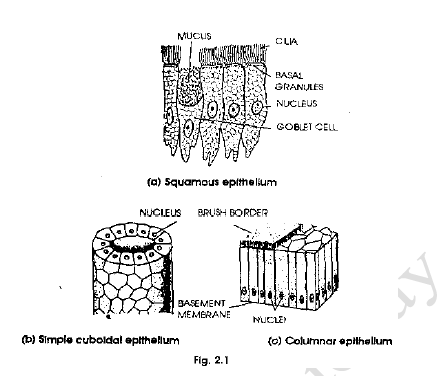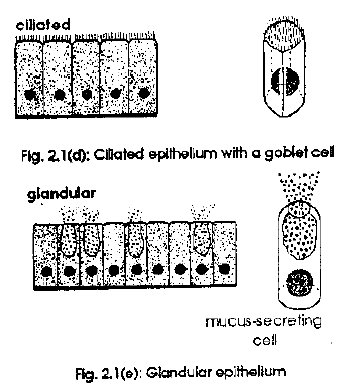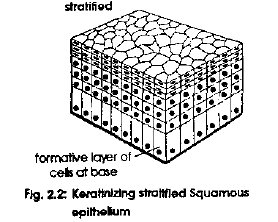2.1.1 Introduction
In one celled organisms, the single cell perform all the activities like ingestion, exertion, digestion, osmoregulation etc. whereas in multicellular organisms cells undergo differentiation and each type of cell is specialized to perform a specific function or a set of functions. Group of similar cells tissue e.g., Nervous tissue, Connective tissue, Histology is the branch of science which deals multicellular organisms are made up of different types of tissues. Classification of animal tissues based on their function:

(a) Epithelial tissue: Covers or lines the free surfaces of the tissues. It serves several functions such as protection. Secretion, excretion and also forms receptors.
(b) Connective tissue: Supports and connects various tissues.
(c) Muscular tissue: Causes movement of the skeleton and other internal organs b contraction and relaxation.
(d) Nervous tissue: Transmits messages in the form of impulses, thus coordinating the activities of body.
2.1.2 Epithelial Tissue
One of the simplest animal tissues is epithelium, is a lining tissue. In it simplest form it consists of a single layer of cells covering the surface of the animal and the organs, cavities and tubes within it. The epithelium lining the inside of heart, blood vessels and lymph vessels is referred to as endothelium.

Structure: Typically all individual cells of epithelium are firmly attached with each other. These cells rest on a basement membrane.
Functions: Functions are varied and many and involves protection of underlying tissues, production of motion (ciliated epithelium), absorption of digested material, secretory and also sensory function (olfactory region o nose, taste buds of tongue, retina of eye are all example of sensory functions of epithelium).
Epithelia are classified on the basic of shape, function and number o layers it is made up of.
1. Simple squamous epithelium: In such a type of epithelium, the cells are flattened. This gives a sheet like appearance in surface view. It is found in places where the protective covering also needs to be readily permeable to molecules in solution for e.g., the lining of capillaries, alveoli
in lungs (refer Figure 2.1 (a)).
2. Columnar epithelium: Cells are elongated and are at right angles to the basement membrane. In section they appear tall and column-lie Columnar epithelium is found lining the intestine where it plays important role in supporting other types of cells and absorbing soluble food materials. Columnar cells in intestine and kindly tubule possess microvilli which increases the surface area for absorption (Refer Figure 2.1 (b)).
3. Cuboidal epithelium: Cells are cubical in shape (Refer Figure 2.1(c)). Normally this epithelium forms the lining of glands or their ducts. A classical example is the epithelial lining of the follicles of thyroid (Refer Figure 2.1 (c)).
4. Ciliated epithelium: A specialized form of lining tissue is ciliated epithelium. Usually columnar in shape, the free surface of each

cell bears numerous cilia capable of beating rapidly and rhythmically. This helps in causing motions producing currents. In mammals ciliated epithelium lines tubes and cavities in which materials have to be moved e.g., ciliated epithelium is found lining the respiratory fract for expelling dust particles; in oviduct ciliated epithelium causes movement of ova. (Refer Figure 2.1 (d)).
5. Glandular epithelium: These glandular cells are often interspersed among other epithelial substances – examples of this is seen in the lining of mammalian intestine. Among columnar epithelial cells are large number of cells which secrete mucus into lumen. Mucous is protective as well as lubricating. (Refer Figure 2.1 (e)).

6. Stratified epithelium: Stratified epithelium is sometimes, referred to as compound epithelium as it is made up of a series of layers. It is much thicker than ordinary epithelium.Epidermis of skin is an example o stratified epithelium. The cells at the base are the formative layer and have the capacity to divide and redivide. As multiplication continues, the daughter cells get pushed outwards. As the cells move outwards, they become flattened, keratinized and dead (Refer Figure 2.2).

2.1.3 Connective Tissue
Tissues and organs in an animal’s body must be supported and held in position. This function is performed by connective tissue which binds organs and tissues. Connective tissue fill the spaces between organs and binds organs and tissues together. The connective tissue provides the structural frame work and mechanical support to the organs. It also plays a role in body defence, cells, fibres and a matrix or ground substance. The nature of the matrix provides the basis for a classification of connective tissue into three main types. The cells present in the matrix of connective tissue are (1) fibroblast which secrete fibres and matrix (2) macrophages,which ingest cell debris, bacteria etc., (3) Lympocytes producing antibodies (4) Mast cellproducing heparin which prevents coagulation of blood inside blood vessels.
The fibres of the connective tissue are; (1) White collagen fibres which provide great tonsile strength (2) Yellow elastin fibres, which are elastic and (3) reticular fibres that a fine branching and support the cells. The matrix is a non living substance may be rigid, gelatinous.Blood and lymph may be considered a form of connective tissue in which the matrix is fluid. In connective tissue proper, the matrix is soft, jelly-like and amorphous,

